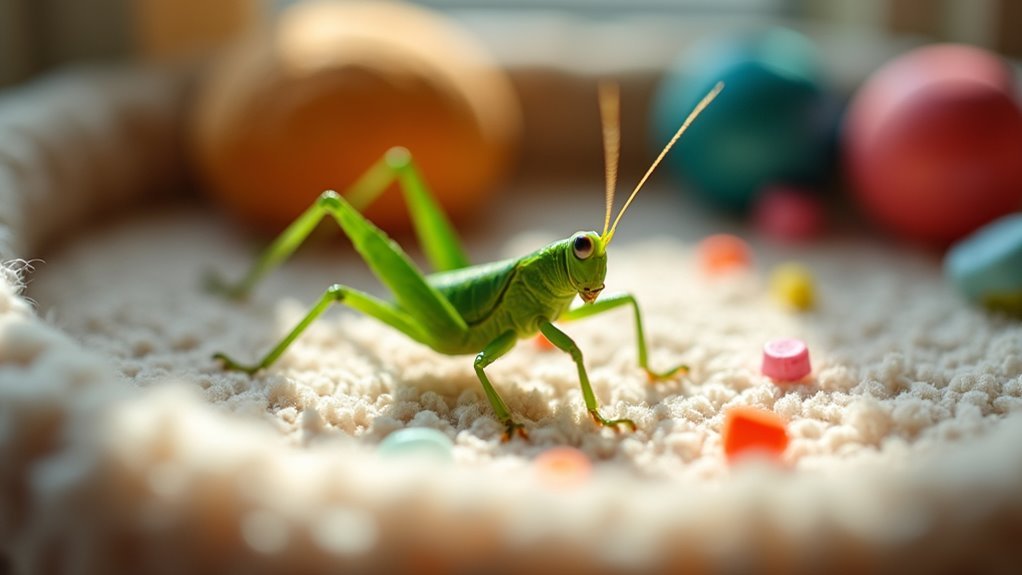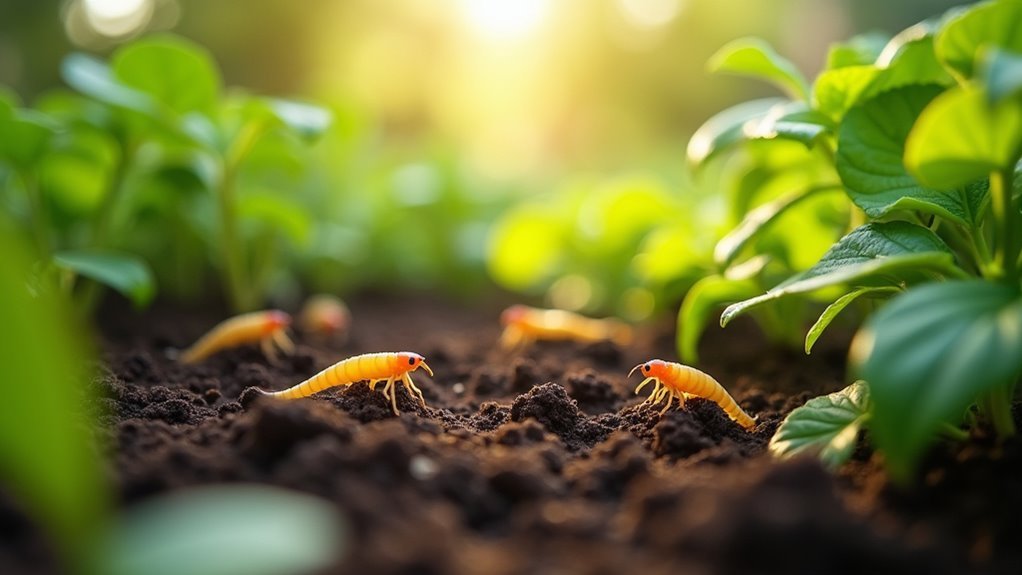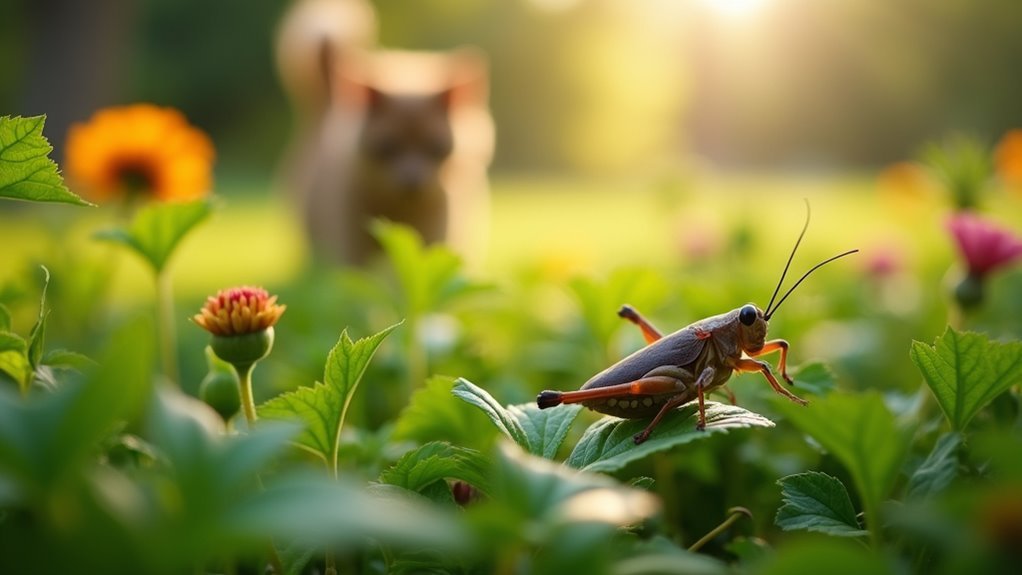You’ll need to remove crickets safely around pets because traditional pesticides contain toxic chemicals like pyrethroids and organophosphates that can poison your furry companions. These harmful ingredients cause severe reactions including vomiting, diarrhea, tremors, and even neurological damage in dogs and cats. Cricket behavior also triggers your pets’ hunting instincts, leading to stressful chase scenarios and potential injuries from rough play. Safe removal methods protect both your pets’ health and create a cricket-free environment through natural alternatives and proper cleanup techniques.
Understanding Cricket Behavior Around Household Pets

When crickets enter your home, they’ll typically display predictable behaviors that can help you understand how they might interact with your pets.
House cricket movements are characterized by sudden jumping when startled, which can trigger your pet’s natural curiosity or hunting instincts. This unpredictable motion often leads to chase scenarios where both animals may experience stress or potential injury.
A cricket’s erratic jumping behavior can instantly activate your pet’s hunting drive, potentially creating stressful chase situations for both animals.
Your pet might view crickets as toys or prey, leading to attempted capture or consumption. While crickets don’t bite, their presence can create excitement that results in rough play.
If you’re keeping crickets intentionally, monitor these interactions closely. The cricket’s defensive jumping response combined with your pet’s predatory behavior creates situations requiring careful observation to prevent accidental harm to either animal during their encounters.
Identifying Pet-Toxic Pesticides and Chemical Treatments
Before reaching for any cricket control product, you’ll need to recognize which pesticides can harm your pets and understand the warning signs of poisoning.
Many commercial insecticides contain dangerous chemicals like pyrethroids and organophosphates that can cause severe reactions in dogs and cats, ranging from digestive upset to neurological damage.
Fortunately, you can protect your furry friends by learning to spot these toxic ingredients and choosing safer alternatives that effectively eliminate crickets without putting your pets at risk.
Common Toxic Ingredients
Since many homeowners reach for conventional pesticides without considering the dangers to their furry companions, it’s essential you understand which common ingredients pose serious health risks.
Organophosphates and carbamates in insecticides around the home can cause vomiting, diarrhea, and seizures if your pet ingests or absorbs them through their skin.
Glyphosate-based herbicides have been linked to cancer in pets, making them particularly dangerous for pest control in areas where animals roam.
Pyrethroids, despite being marketed as household-safe, trigger neurological symptoms in cats and dogs who contact treated surfaces.
Insect growth regulators disrupt hormonal functions, potentially causing developmental problems.
Always check labels for these active ingredients and choose pet-safe alternatives like diatomaceous earth instead.
These substances are extremely toxic to pets.
Pet Poisoning Symptoms
Recognizing pesticide poisoning symptoms in your pets can mean the difference between life and death, as these toxic reactions often develop rapidly after exposure.
Pet poisoning symptoms from toxic pesticides typically manifest within hours and require immediate attention.
Watch for these critical warning signs:
- Digestive distress – Vomiting, diarrhea, and excessive drooling indicate your pet’s system is rejecting harmful substances.
- Respiratory problems – Difficulty breathing signals severe toxicity requiring emergency care.
- Neurological symptoms – Tremors, seizures, and loss of coordination suggest dangerous chemical exposure.
- Behavioral changes – Lethargy or unusual restlessness can indicate systemic poisoning.
Ingestion of treated insects poses particular risks, as pets consume concentrated toxins directly.
Contact your veterinarian immediately if you notice any combination of these symptoms after potential pesticide exposure.
Safe Alternative Methods
When you’re dealing with cricket infestations, many conventional pesticides contain compounds that’ll endanger your pets’ health. Pyrethroids can cause vomiting, seizures, or death if your animals ingest or absorb them through their skin.
Instead, you can use safe alternative methods that effectively control crickets without risking your pets’ wellbeing. Diatomaceous earth serves as one of the best natural alternatives when applied correctly in areas away from your pets.
You can also create homemade traps using molasses to capture crickets without toxic chemicals. Essential oils like peppermint or tea tree oil deter crickets, though you’ll need proper dilution since some oils harm pets if ingested.
Always consult your veterinarian before implementing any pet-safe pest control strategy.
Natural Molasses Trap Methods for Cricket Control
One of the most effective natural methods for cricket control involves using molasses traps that safely eliminate these pests without endangering your furry companions.
Pet-safe molasses traps offer an effective, natural solution for cricket elimination without risking harm to your beloved animals.
These natural molasses traps work by attracting crickets with their sweet scent, causing them to become trapped in the thick substance where they’ll quickly perish.
Here’s how to create your own cricket molasses trap:
- Fill a jar with molasses and position it against a wall or surface where you’ve noticed cricket activity.
- Wrap a rag around the jar’s rim to create a climbing surface that helps crickets access the trap.
- Place multiple traps in areas where crickets congregate for maximum effectiveness.
- Check and refresh regularly to maintain the trap’s attractiveness and remove captured insects.
Using Beneficial Nematodes as Pet-Safe Solutions

For pet owners seeking an advanced biological solution, beneficial nematodes offer microscopic warfare against cricket populations without putting your furry friends at risk. These non-segmented roundworms parasitize soil-dwelling crickets in a pet-safe manner while leaving beneficial insects unharmed.
| Nematode Feature | Benefit |
|---|---|
| 50+ Species Available | Target various cricket types |
| Microscopic Size | Penetrate soil effectively |
| Long-lasting Control | Survive several months |
| Biological Method | Chemical-free application |
| Selective Targeting | Harmless to pets/humans |
You’ll apply nematodes directly to soil where they actively seek crickets and reduce populations naturally. This sustainable pest management approach eliminates chemical pesticide risks while providing months of protection. The nematodes work continuously underground, creating an invisible barrier that controls cricket infestations safely.
Creating Physical Barriers and Exclusion Techniques
You can create effective physical barriers to keep crickets away from your pets without using harmful chemicals.
Start by sealing entry points like cracks in walls, foundations, and around windows using caulk or weather stripping to block cricket access routes.
Install fine mesh screens on windows, doors, and vents to prevent crickets from entering while maintaining proper airflow in your home.
Sealing Entry Points
Three fundamental barriers stand between crickets and your pet’s living space: sealed openings, maintained screens, and weatherproofed foundations.
Sealing entry points creates an effective defense system that’ll reduce likelihood of unwanted cricket encounters while maintaining a safe environment for your furry companions.
Focus on these critical areas for managing cricket populations:
- Door and window gaps – Apply weather stripping around frames and use caulk to fill visible cracks
- Foundation crevices – Seal gaps between your home’s foundation and exterior walls with appropriate sealant
- Screen maintenance – Repair torn window and door screens to allow ventilation while blocking insects
- Outdoor space management – Trim overgrown vegetation and clear debris near your home’s perimeter
These exclusion techniques protect pets from potential allergens and irritants while preventing cricket infestations.
Installing Mesh Screens
Beyond sealing gaps and cracks, mesh screens provide your next layer of defense against cricket invasions. Installing mesh screens on windows and doors creates physical barriers that prevent crickets from entering while maintaining airflow and natural light.
You’ll need mesh with openings of 1/16 inch or smaller to block even tiny crickets effectively.
Don’t forget to screen vents and exhaust fans – these often-overlooked entry points can compromise your exclusion strategy. Regular inspection is essential to maintain effectiveness. Check for holes, tears, or loose sections that could allow pest entry.
When you combine mesh screens with proper sealing around frames, you’ll create a thorough barrier system. This dual approach greatly reduces cricket invasions while keeping your home comfortable and well-ventilated for both family and pets.
Essential Oils and Plant-Based Repellent Options

While commercial cricket repellents often contain harsh chemicals that pose risks to your furry companions, natural alternatives offer effective protection without compromising your pets’ safety.
Essential oils and plant-based repellents create a safe environment while effectively deterring crickets. Here are four non-toxic options you can use:
- Essential oils – Dilute peppermint, eucalyptus, or citronella oils and spray around cricket-prone areas.
- Neem oil – Apply this plant-based solution to keep crickets away naturally.
- Diatomaceous earth – Sprinkle this fossilized algae powder where crickets gather.
- Repellent plants – Grow lavender and rosemary indoors or in your garden.
Always verify that any essential oils you’re using are pet-safe, as certain oils can harm cats and dogs if ingested or applied directly to their skin.
Proper Cleanup and Disposal After Cricket Removal
Once you’ve successfully removed crickets from your home, proper cleanup becomes essential for maintaining your pets’ health and preventing future infestations.
You’ll need to remove any dead crickets immediately, as decomposing insects attract pests and spread diseases like Salmonella. Always wear gloves when handling cricket remains to protect yourself from bacteria transfer.
Clean all surfaces thoroughly with a disinfectant designed for animal environments, ensuring you’ve eliminated residual waste and food particles.
Thoroughly disinfect all surfaces with animal-safe cleaners to eliminate cricket waste and food residue completely.
Don’t forget to dispose of uneaten food and old bedding materials in sealed bags to prevent dangerous mold growth that threatens both you and your pets.
Finally, monitor the area regularly for leftover crickets or droppings to maintain a safe, clean environment for your furry companions.
Monitoring Pet Health During Pest Control Activities
After completing your cleanup routine, you must watch your pets carefully throughout the entire pest control process.
Monitoring pet health during pest control activities requires vigilance and immediate response to any concerning symptoms.
Here’s what you should focus on when monitoring pet health:
- Check for adverse reactions like vomiting, diarrhea, lethargy, or changes in appetite after using cricket removal products.
- Ensure all products are labeled as safe for pets before application and follow instructions precisely.
- Keep pets away from treated areas until surfaces have completely dried and it’s safe for re-entry.
- Remove deceased crickets and traps immediately to prevent your pet from ingesting harmful materials.
Contact your veterinarian immediately if you notice any unusual behavior or symptoms in your pets.
Long-Term Prevention Strategies for Cricket-Free Homes
Since you’ve successfully removed crickets and protected your pets during the process, establishing long-term prevention strategies becomes your next priority for maintaining a cricket-free home. Focus on eliminating conditions where crickets thrive by addressing moisture issues and removing attractants like cricket food from pet feeding areas.
| Indoor Prevention | Outdoor Prevention |
|---|---|
| Seal foundation cracks and gaps | Trim tall grass regularly |
| Control humidity with dehumidifiers | Store firewood away from house |
| Vacuum regularly to remove food sources | Remove yard debris and clutter |
| Clean up spilled pet food promptly | Improve drainage around moist dirt areas |
Maintain these practices consistently to prevent crickets from establishing colonies. Regular yard maintenance and moisture control create an environment that’s inhospitable to cricket populations while keeping your pets safe.
Frequently Asked Questions
Are Crickets Harmful to Pets?
Crickets aren’t harmful to your pets in small amounts, but they can cause digestive upset or blockage if consumed in large quantities. You should monitor for allergic reactions and potential parasites.
Are Crickets Bad to Have Around Your House?
Crickets aren’t inherently bad, but you’ll want to address them since they indicate moisture problems, create noisy disturbances at night, reproduce quickly, and can attract other pests like spiders into your home.
Should You Get Rid of Crickets?
You should remove wild crickets from your house since they’ll chirp constantly, potentially harm pets if eaten in large quantities, and might carry parasites or diseases that could affect your animals.
Do Pet Store Crickets Have Parasites?
Pet store crickets can carry parasites like nematodes, mites, and worms that’ll harm your pets. You should buy from reputable suppliers, quarantine new crickets, and watch for illness signs before feeding them.
In Summary
You’ve learned multiple pet-safe methods to eliminate crickets without risking your furry friends’ health. Don’t resort to toxic chemicals when natural solutions like molasses traps, beneficial nematodes, and essential oils work effectively. Keep monitoring your pets during any pest control activities, and remember that prevention’s always better than treatment. By combining physical barriers, proper cleanup, and long-term prevention strategies, you’ll maintain a cricket-free home while keeping your pets completely safe.





Leave a Reply